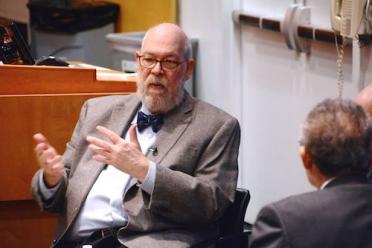
In December 2017, after months of debate, the US government passed a sweeping new tax law, the Tax Cuts and Jobs Act. In the lead-up to the law’s passage, proponents touted a wide range of economic benefits, contending that the lower corporate tax rate prescribed by the law will lead to faster economic growth, wage increases, and more jobs. But does the legislation have the potential to achieve those results?
This question was the focus of a panel discussion hosted by the Richard Paul Richman Center for Business, Law, and Public Policy on March 26, 2018. The event brought together Michael Graetz, Columbia Alumni Professor of Tax Law at Columbia Law School; Daniel Shefter '93, former partner at Goldman Sachs and lecturer in law at Columbia Law School; and Robert Willens, president of Robert Willens, LLC, and adjunct professor at Columbia Business School. The discussion, moderated by Richman Center Senior Fellow Jesse J. Greene Jr., focused on the major business-related provisions of the law, its impact on the domestic economy, and the ways that businesses are likely to adapt to the changes. The panelists’ outlook on the law was somber, with all three expressing skepticism that the reform will lead to significant economic resurgence.
Introducing the major business provisions of the law, Graetz pointed to the lowering of the federal corporate tax rate as the most significant change. There had long been bipartisan desire to lower this rate—previously 35 percent, one of the highest in the world—and the new rate of 21 percent has been largely welcomed across the political aisle. To those concerned that this change favors the owners of corporate stock, Graetz noted that a solution could be found in raising the shareholder tax rate, rather than raising the corporate rate back up. Graetz also emphasized the law’s treatment of pass-through entities—that is, entities like S corporations or partnerships, profits from which “pass through” to their owners and are taxed at those individuals’ income rates—as a major change. The new law allows a 20 percent deduction on pass-through income, incentivizing businesses to restructure as partnerships and employees of businesses to become independent contractors.
The sheer volume of changes in the legislation is likely to cause temporary confusion at the very least. The far more problematic issue is the law’s potential to increase the national debt. The Republican Party has claimed that the tax cuts will add up to $1.5 trillion to the national debt, but that economic growth will help offset these costs, leading the tax law to “pay for itself.” Graetz and Shefter strongly opposed these claims. Graetz noted that the many phase-ins, phase-outs, sunsets, and extensions built into the legislation are likely to double the cost, bringing it closer to $3 trillion. Considering that the US national debt stands at roughly 75 percent of GDP, with nearly half owed to foreigners, such an increase merits significant alarm. With all of the extensions in the law taken into account, “we are going to see trillion-dollar deficits beginning in 2019, I would guess,” said Graetz. In his view, the tax system is not sustainable.
Shefter noted that the sheer volume of change is fueling uncertainty and confusion. The law’s many complexities require a “tremendous amount of regulations in a very short period of time,” said Shefter, a situation that is further complicated by the fact that the US currently has a “woefully understaffed Treasury Department and IRS and a president who hates regulation.” No matter the staffing shortages or attitudes, with the law’s multitude of provisions scheduled to take effect through the next year, the need to create regulations to guide taxpayers is undeniable.
The legislation’s complexity has also contributed to some accelerated activity in financial transactions, Willens added. The lack of clear provisions about the eligibility of members of an affiliated or consolidated group to be treated as a single entity, for example, is spurring discussions of mergers. And given the disparity between corporate and individual tax rates, master limited partnerships (MLPs) have shown an interest in incorporating.
And are the economic benefits of the new corporate rate—namely, faster economic growth, higher wages, more jobs, and the return of offshore cash—likely to come true? The panel remained highly skeptical. Shefter noted that wage increases in 2018 have been largely due to other factors, like minimum wage increases enacted by more than a dozen states. On the issue of jobs, Shefter warned the audience to remember that the national unemployment rate is structurally low, falling below the natural unemployment rate, and is likely to cause a shortage if more workers are not allowed into the country. And addressing the question of whether companies will repatriate offshore earnings and revitalize the domestic economy in the process, Shefter warned audiences not to be overly optimistic. Companies are likely to pay down debt and return money to shareholders, and thus far, public announcements of capital changes have not indicated that US companies are making investment choices that they otherwise would not have. Addressing the possibility of companies relocating manufacturing to the US, Shefter noted that a lower tax rate is a “modest incentive for someone at the margin,” but that taxes are only a small part of the complex decision-making process behind the location of operations.
Concluding their discussion, the panelists took questions from the audience on topics including the tax law’s compliance with World Trade Organization regulations, effects on M&A and other deals, the future of individual tax rates, and considerations for estate planning.
